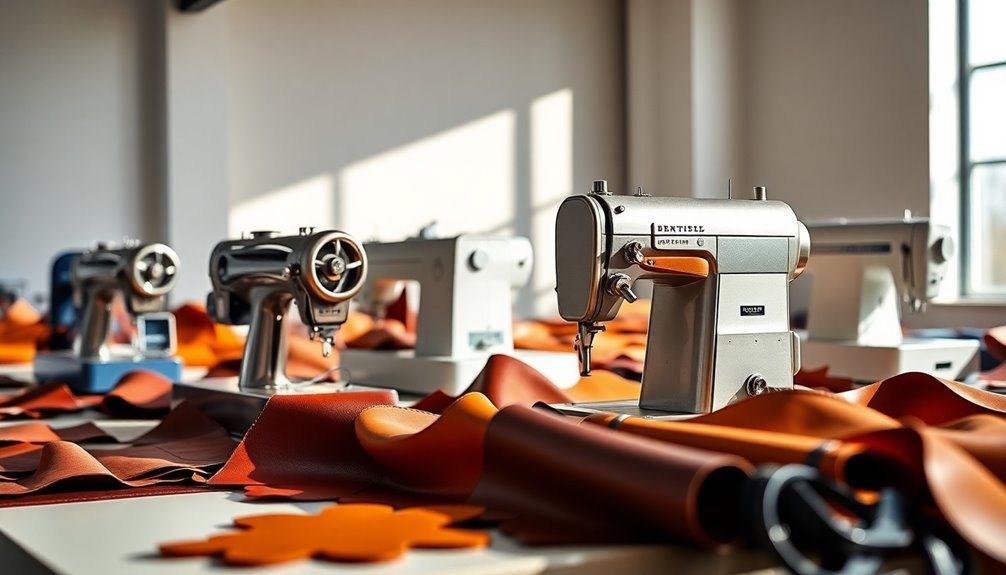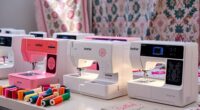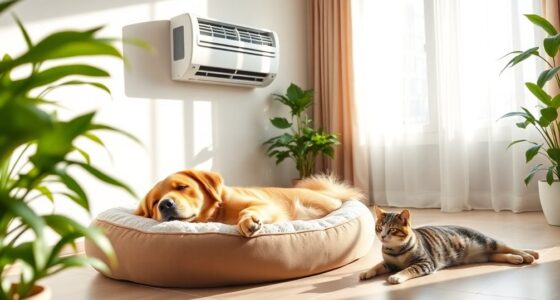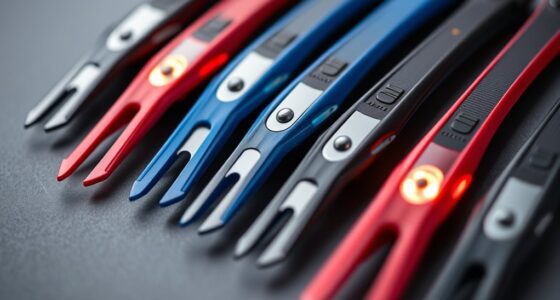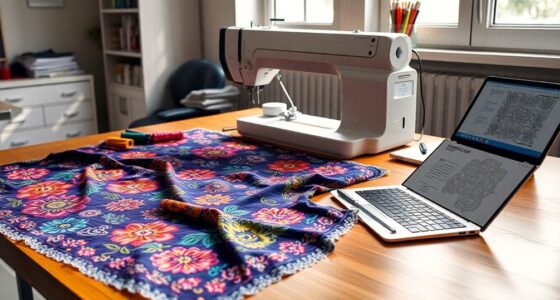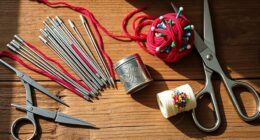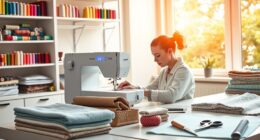I've spent a lot of time exploring sewing machines specifically for leather projects, and it's essential to find one that meets your needs. From heavy-duty models to compact cobbler machines, each has unique benefits and drawbacks. You'll want to take into account features like speed, durability, and needle compatibility when making your choice. If you want the best picks for your leather crafting needs, stick around—I've got some great recommendations coming up!
Key Takeaways
- Look for machines with high sewing speeds (1,100 to 3,000 stitches per minute) to enhance productivity for leather projects.
- Choose machines with strong motors and metal frames for durability and consistent performance on heavy-duty materials.
- Ensure compatibility with leather-specific needles and heavier-weight threads for optimal sewing results on tough fabrics.
- Consider user-friendly features and included accessory kits to aid beginners and enhance ease of operation.
- Evaluate the pros and cons of each model, including maintenance needs, portability, and warranty options for long-term use.
Shoe Repair Machine – Manual Dual Cotton Nylon Line Sewing Machine
If you're looking for a reliable machine to tackle leather projects, the Shoe Repair Machine – Manual Dual Cotton Nylon Line Sewing Machine is an excellent choice for DIY enthusiasts and professionals alike. This compact, durable machine is made from aluminum alloy, ensuring it lasts through countless projects. I love how it allows me to sew through multiple layers of leather without missing a stitch. The manual drive gives me precise control over my sewing, making it feel almost like hand-stitching. Just keep in mind that some setup can be tricky, but once you get the hang of it, it's incredibly rewarding!
Best For: DIY enthusiasts and professionals looking for a durable and precise sewing machine for leather and various materials. This sewing machine is not only ideal for leather but also excels at handling a wide range of fabrics, making it one of the best sewing machines for fabric on the market. Its robust construction ensures longevity, while advanced features such as adjustable tension and speed control provide unmatched precision for all your sewing projects. Whether you’re mending clothes or creating custom leather goods, this machine is designed to deliver professional results every time.
Pros:
- Versatile machine suitable for sewing leather, rubber, clothes, and more.
- Manual drive allows for precise control and stitch accuracy.
- Compact design makes it easy to assemble, install, and use at home.
Cons:
- Initial setup can be challenging due to a learning curve with bobbin and threading.
- Reports of sharp edges, rust, and corrosion requiring maintenance.
- Mixed feedback on build quality and assembly stability.
Leather Sewing Machine for Shoe Repair and Upholstery
For anyone looking to tackle shoe repair or upholstery projects, the Leather Sewing Machine Cobbler Stitching Machine stands out as an excellent choice thanks to its robust construction and versatility. Weighing just under 20 pounds, it's compact yet powerful enough to handle heavy materials like leather and nylon. I appreciate its manual drive, which gives me control over stitching strength and accuracy. Although some users mention a steep learning curve, I found helpful resources online. Just a heads up: be cautious of sharp edges during setup. Overall, it's a solid machine for both home crafters and professionals alike.
Best For: Home crafters, clothing designers, and professionals looking for a durable sewing machine for shoe repair and upholstery projects.
Pros:
- Robust construction made from durable aluminum alloy, ensuring longevity.
- Versatile usage allows for sewing a variety of materials and projects, including shoes, bags, and upholstery.
- Manual drive control provides precision in stitching strength and accuracy for detailed work.
Cons:
- Steep learning curve reported by some users, which may require additional time to master.
- Sharp edges during setup pose a safety risk if not handled carefully.
- Initial quality issues noted by some users, including assembly challenges and mechanical adjustments needed.
FAHKNS Handheld Leather Sewing Machine
The FAHKNS Handheld Leather Sewing Machine stands out as an excellent choice for hobbyists and professionals alike who need a portable and powerful tool for leather projects. Weighing just under five pounds, this aluminum alloy machine is compact yet durable. The manual drive method gives me control over strength and accuracy, making it perfect for various materials, including leather, rubber, and cloth. While the initial setup can be a bit tricky, following the instructions and lubricating moving parts makes a significant difference. I recommend using leather-specific needles and keeping extra bobbins on hand for a smoother experience.
Best For: Hobbyists and professionals seeking a portable and powerful sewing machine for leather and other heavy materials.
Pros:
- Durable Construction: Made from strong aluminum alloy, ensuring longevity and reliability.
- Manual Control: Allows users to have precise control over sewing strength and accuracy.
- Versatile Capability: Can sew various materials, including leather, rubber, and cloth, making it suitable for diverse projects.
Cons:
- Tricky Setup: Initial assembly and adjustments can be time-consuming and may require patience.
- Lacking Instructions: Some users find the provided instructions insufficient for optimal setup.
- Maintenance Required: Regular lubrication and adjustments are necessary for smooth operation and best performance.
SINGER Heavy Duty 4432 Sewing Machine
SINGER Heavy Duty 4432 stands out as an excellent choice for anyone tackling leather projects due to its robust motor and impressive stitching capabilities. With a strong motor that pierces multiple layers easily, I've found it incredibly efficient. This machine boasts 110 stitch applications, a built-in needle threader, and an extra high sewing speed of up to 1,100 stitches per minute. Users often rave about its durability and attractive design. While some have reported mechanical issues, when it functions correctly, it's a reliable investment for both beginners and seasoned sewers looking to enhance their leather crafting experience.
Best For: The SINGER Heavy Duty 4432 is best for both beginners and experienced sewers who are looking for a reliable machine capable of handling a variety of fabrics, including leather.
Pros:
- Strong motor that provides enhanced piercing power for multiple layers and tough materials.
- High sewing speed of up to 1,100 stitches per minute, allowing for efficient project completion.
- Versatile stitch applications with 110 options, catering to various sewing needs and styles.
Cons:
- Reports of mechanical issues, such as bobbin case misalignment, affecting performance.
- Some users have experienced difficulties in operation, despite following instructions closely.
- Concerns regarding quality control have led to dissatisfaction for some, with difficulties obtaining refunds for malfunctioning units.
SINGER Heavy Duty 4452 High Speed Sewing Machine
If you're tackling leather projects, the SINGER Heavy Duty 4452 High Speed Sewing Machine stands out with its powerful motor and impressive stitching speed. With 110 stitch applications, including basic and decorative options, it's versatile enough for any task. I love its full metal frame, which guarantees stability during use. The built-in needle threader and top drop-in bobbin simplify setup, while the adjustable stitch length and width let me customize my projects easily. Users rave about its ability to handle thick fabrics without tension issues, making it a reliable choice for both beginners and seasoned sewists alike.
Best For: The SINGER Heavy Duty 4452 High Speed Sewing Machine is best for both beginners and experienced sewists looking to tackle a variety of projects, including thick fabrics and intricate designs.
Pros:
- Powerful motor allows for sewing through multiple layers and thick materials with ease.
- Versatile stitch options with 110 applications, including decorative and basic stitches.
- Durable construction with a full metal frame ensures stability and longevity.
Cons:
- Some users report noise during operation, which may be distracting.
- Issues with the upright spool pin can lead to thread jams for some users.
- Limited advanced features compared to higher-end models might not satisfy professional tailors.
FAHKNS Handheld Leather Sewing Machine for Shoe Repair
For anyone looking to tackle shoe repairs or craft leather projects, the FAHKNS Handheld Leather Sewing Machine stands out with its strong, durable aluminum alloy construction. Weighing just under five pounds, it's lightweight yet sturdy, making it easy to handle. The manual drive method gives you control over strength and accuracy, which is vital for sewing various materials like leather and rubber. While the setup may take a bit of time, following the instructions guarantees smooth operation. Users appreciate its value, especially for heavy materials. Just remember to use leather-specific needles and threads for the best results!
Best For: Individuals seeking an affordable and effective solution for shoe repairs and leather crafting projects.
Pros:
- Strong and durable aluminum alloy construction ensures long-lasting performance.
- Manual drive method provides control over sewing strength and accuracy for various materials.
- Value for money, especially for those needing to sew heavy materials like leather and webbing.
Cons:
- Initial setup can be time-consuming, with some users finding instructions lacking.
- Modifications may be required for optimal performance, particularly when working with leather.
- Lubrication and maintenance are necessary for smooth operation, which may be a hassle for some users.
SINGER Heavy Duty 4432 Sewing Machine
The SINGER Heavy Duty 4432 Sewing Machine stands out with its powerful motor and impressive speed of up to 1,100 stitches per minute, making it an excellent choice for anyone tackling leather projects. I love the 110 stitch applications, which include everything from basic to decorative stitches. The full metal frame guarantees stability, and the top drop-in bobbin makes monitoring easy. Many users rave about its speed and ability to handle multiple layers. While some report mechanical issues, when it's working properly, this machine is a fantastic investment for both beginners and experienced sewists alike.
Best For: The SINGER Heavy Duty 4432 Sewing Machine is best for both beginner and experienced sewists looking for a reliable and fast machine capable of handling various fabrics, including leather and denim.
Pros:
- High-speed performance with up to 1,100 stitches per minute, making sewing projects quicker.
- Versatile stitch options with 110 applications, catering to different sewing needs from basic to decorative.
- Sturdy design with a full metal frame that enhances stability and durability during use.
Cons:
- Reports of mechanical issues, such as bobbin case misalignment, which can hinder performance.
- Quality control concerns, with some users describing their machines as "complete junk."
- Difficulty in obtaining refunds for malfunctioning machines, leading to frustration for some users.
SINGER Heavy Duty 4432 Sewing Machine
When tackling leather projects, the SINGER Heavy Duty 4432 Sewing Machine stands out for its powerful motor and impressive piercing capability. With a speed of up to 1,100 stitches per minute, this machine easily handles thick materials. I love the 110 stitch applications, including decorative options and a one-step buttonhole feature. Its heavy-duty metal frame guarantees stability, making it a reliable choice for any project. Plus, the built-in LED lighting brightens my workspace. Users rave about its ease of use, making it perfect for both newbies and seasoned pros. Overall, it's a fantastic investment for serious sewing enthusiasts.
Best For: The SINGER Heavy Duty 4432 Sewing Machine is best for sewing enthusiasts who require a reliable and powerful machine for various fabric types, including heavy materials like leather.
Pros:
- High-speed performance with up to 1,100 stitches per minute, allowing for efficient sewing.
- Versatile stitch options with 110 applications, including basic, stretch, decorative, and one-step buttonhole stitches.
- Durable construction with a heavy-duty metal frame that ensures stability and longevity.
Cons:
- Maintenance challenges may arise over time, requiring more attention than some users anticipate.
- Potential mechanical concerns reported by a few users, indicating variability in long-term reliability.
- Weight of the machine (14.6 lbs) could be cumbersome for some users seeking portability.
Manual Leather Sewing Machine for Shoe Repair
If you're looking to tackle shoe repairs with ease, the Manual Leather Sewing Machine Hand Shoe Cobbler Stitching Repair Mending Machine is an excellent choice. Its compact design and adjustable needle distance make it versatile for various materials, from leather to rubber. I found the assembly straightforward, though some users recommend watching tutorials for extra help. Once set up, this machine excels at sewing thick materials, ensuring your repairs hold up. Just keep in mind that it may arrive with excess grease, so a quick clean is necessary. Overall, it's a reliable option for DIY shoe repair enthusiasts.
Best For: DIY shoe repair enthusiasts looking for a versatile and compact sewing machine that can handle various materials.
Pros:
- Versatile: Can sew through different materials including leather, rubber, and cloth with adjustable needle distance.
- Compact Design: Easy to store and handle, making it suitable for home use.
- Robust Performance: Effectively sews thick materials once properly set up, ensuring durable repairs.
Cons:
- Assembly Challenges: Some users report difficulties with assembly and unclear instructions.
- Initial Setup Issues: May require fine-tuning and adjustments to function optimally.
- Excess Grease: The machine may arrive with excess grease, necessitating a clean before initial use.
Cobbler Sewing Machine for Leather and Fabrics
For anyone tackling leather projects, the 2021 Cobbler Sewing Machine stands out as a capable tool, especially for those who work with thick materials like bags and shoes. Its powerful 250W motor and stainless steel base make it reliable for various applications, from coats to quilts. However, I found the assembly challenging, with unclear instructions and misaligned bolt holes. Users should also be prepared for a learning curve in speed control. While it requires regular maintenance and may need extra parts, it offers unique value for serious crafters who appreciate its robust design. Just be ready for some patience!
Best For: The 2021 Cobbler Sewing Machine is best for serious crafters and DIY enthusiasts who frequently work with thick materials like leather and heavy fabrics.
Pros:
- Powerful Motor: The 250W motor provides reliable performance for sewing through thick materials.
- Versatile Applications: Suitable for a wide range of projects including bags, shoes, and garments.
- Stainless Steel Base: Enhances durability and stability during operation.
Cons:
- Challenging Assembly: Inadequate instructions and misaligned bolt holes can complicate setup.
- Learning Curve: Users may struggle with speed control, requiring practice to operate effectively.
- High Maintenance: Regular oiling and sourcing compatible parts may be necessary for optimal performance.
Cobbler Shoe Repair Machine
The Cobbler Shoe Repair Machine stands out as an ideal choice for those passionate about tackling leather projects, especially shoe repairs. With its robust construction and strengthened materials, it's designed for durability. Weighing 20.3 pounds and measuring 21 x 13 x 6 inches, it's a solid investment. While some users report assembly challenges, the clear instructions help streamline the process. I appreciate the hands-on experience it offers, allowing me to learn sewing mechanics. Just keep in mind that it's not a plug-and-play model; be ready to invest some time and effort to make it work perfectly for your needs.
Best For: This product is best for DIY enthusiasts and hobbyists who enjoy learning about sewing machine mechanics and are looking for a project-oriented machine for leather repairs.
Pros:
- Durable construction: Made with strengthened materials and double bearings for enhanced longevity.
- Educational experience: Offers a hands-on opportunity to learn and troubleshoot sewing mechanics.
- Versatile use: Suitable for a variety of leather projects, including shoes, bags, and clothing.
Cons:
- Assembly challenges: Some users report difficulties with setup, requiring adjustments and mechanical knowledge.
- Not plug-and-play: Requires time and effort to optimize performance and functionality.
- Mixed user feedback: Performance can vary significantly, with some needing modifications to achieve satisfaction.
Leather Sewing Machine for Thick Material
Designed specifically for those tackling tough leather projects, this heavy-duty sewing machine excels at handling thick materials with ease. With a maximum speed of 3000 stitches per minute, it's perfect for leather, knitted fabric, and canvas. The robust design features a large double thread rotary bobbin and adjustable stitch length of up to 8mm. I love the automatic oil spraying device, which keeps everything running smoothly. Plus, its low noise level makes it great for home use. Just remember, the motor and table are sold separately, so plan accordingly. This machine truly is a game-changer for serious sewing enthusiasts!
Best For: This sewing machine is best for serious sewing enthusiasts and professionals who need to work with thick materials like leather, knitted fabric, and canvas.
Pros:
- Heavy-duty design allows for seamless sewing of thick fabrics.
- High-speed operation up to 3000 stitches per minute enhances productivity.
- Automatic oil spraying device ensures smooth operation and reduced maintenance.
Cons:
- Motor and table sold separately, adding to the overall cost.
- Heavier weight (30.3 kg) may make it less portable.
- Requires careful reading of the manual for safe operation and setup.
Leather Sewing Machine for Shoe Repair
When tackling shoe repairs, having a reliable leather sewing machine can make all the difference. I love using a cobbler sewing machine designed for leather because it's built with a strong aluminum alloy, ensuring durability. Its compact design allows for easy portability, and the detachable stand makes storage a breeze. With the ability to handle stitch thicknesses up to 0.24 inches, I can work on various shoes—high heels, leather, or even rubber. Plus, it's compatible with both cotton and nylon threads, giving me the versatility I need for all my repair projects. Just remember to oil the moving parts for smooth operation!
Best For: Individuals looking for a reliable and versatile sewing machine to repair shoes, bags, and other leather items.
Pros:
- Built from durable aluminum alloy for long-lasting performance.
- Compact and portable design with a detachable stand for easy storage.
- Capable of handling various stitch thicknesses and compatible with both cotton and nylon threads.
Cons:
- Requires regular maintenance, including oiling of moving parts.
- May have a learning curve for beginners unfamiliar with sewing machines.
- Limited to specific stitch thickness and disposition ranges, which might not suit all projects.
SINGER Heavy Duty 4411 High Speed Sewing Machine
For anyone tackling leather projects, the SINGER Heavy Duty 4411 High Speed Sewing Machine stands out with its impressive power, offering 50% more strength to handle tough fabrics effortlessly. Weighing just 14.6 lbs, it features a heavy-duty metal frame that guarantees durability and skip-free sewing. With the ability to stitch up to 1,100 stitches per minute, you can complete projects quickly. The adjustable presser foot pressure allows me to work with both heavy and lightweight materials. Plus, the user-friendly setup and included sewing kit make this machine a fantastic choice for any sewing enthusiast looking to craft with leather.
Best For: The SINGER Heavy Duty 4411 High Speed Sewing Machine is best for sewing enthusiasts and professionals who work with heavy fabrics like leather, denim, and canvas.
Pros:
- Powerful Performance: Offers 50% more power for handling tough fabrics effortlessly.
- High-Speed Stitching: Capable of stitching up to 1,100 stitches per minute for quick project completion.
- User-Friendly Features: Easy setup with quick-threading guides and a complete sewing kit included.
Cons:
- Weight: At 14.6 lbs, it may be less portable for users who need to transport their machine frequently.
- Limited Warranty on Parts: The 90-day warranty on adjustments may not be sufficient for long-term users.
- Noise Level: Some users report that the machine can be noisier compared to other models when operating at high speeds.
SINGER Heavy Duty 500 Classic Sewing Machine
The SINGER Heavy Duty 500 Classic Sewing Machine stands out as an excellent choice for leather projects, thanks to its powerful motor that delivers 50% more strength than standard models. I love its vintage-inspired design, which adds charm to my sewing space while housing essential features like a built-in needle threader. With 23 built-in stitches and adjustable settings, I can customize my projects easily. The included accessory kit makes organization a breeze, although I found the threading process a bit tricky at times. Overall, it's user-friendly and offers solid performance, making it a great option for both beginners and seasoned sewers.
Best For: Those seeking a reliable and stylish sewing machine suitable for both beginner and advanced leather projects.
Pros:
- Powerful motor provides 50% more strength than standard machines, allowing for sewing through heavy fabrics effortlessly.
- Vintage-inspired design adds aesthetic appeal while incorporating modern features like a built-in needle threader and easy-to-use stitch settings.
- User-friendly accessories included in the kit promote organization and ease of use.
Cons:
- Some users report difficulty with threading, including issues with thread catching and breaking.
- While generally beginner-friendly, it may have limitations for more advanced sewing projects.
- Concerns about the quality of plastic components potentially affecting durability and overall performance.
Factors to Consider When Choosing a Sewing Machine for Leather Projects
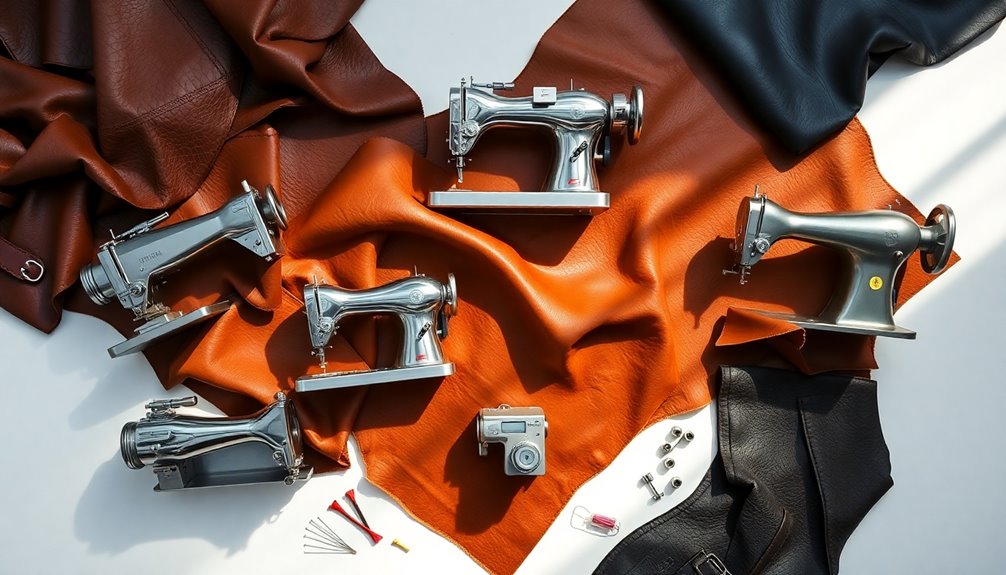
When I choose a sewing machine for leather projects, I consider several key factors. Material compatibility, stitching speed, and needle selection are essential for achieving the best results. I also pay attention to thread compatibility and machine durability to guarantee my sewing experience is smooth and long-lasting.
Material Compatibility
Choosing the right sewing machine for leather projects isn't just about brand or price; compatibility with heavy-duty materials is essential. I've learned that not all machines handle leather, canvas, and thick fabrics well, so it's important to select one specifically designed for these materials. Look for machines that support nylon or cotton threads, as they work best for sewing leather. You'll also want to check the maximum sewing thickness capacity; it should handle multiple layers without compromising stitch quality. Machines with adjustable presser foot pressure can adapt to various thicknesses, enhancing your sewing experience. Finally, a strong motor with enhanced piercing power is critical for consistent performance on tough materials like leather.
Stitching Speed
Stitching speed plays an essential role in the success of leather projects, and I've found that machines can vary markedly in this aspect. Many machines offer speeds ranging from 1,100 to 3,000 stitches per minute, which is fantastic for completing tasks efficiently. Higher speeds boost productivity, especially when tackling multiple layers of thick leather. However, it's vital to choose a machine with adjustable speed settings; slower speeds are often necessary for intricate designs to avoid mistakes. Leather-specific machines usually have stronger motors, providing the piercing power needed for dense materials. Finally, always consider a machine's ability to maintain consistent stitching quality at high speeds to prevent thread tension issues or skipped stitches.
Needle Type Selection
Although selecting the right needle type may seem like a minor detail, it's actually one of the most critical factors for sewing leather successfully. I always opt for leather-specific needles, often labeled as "leather" or "denim." Their wedge-shaped point penetrates the material cleanly, minimizing damage. Needle size matters too; I recommend using a larger needle, such as size 16-18, for thicker leather. This helps prevent issues like skipped stitches or breakage. It's important to match the needle size to the leather thickness. I also make it a habit to change the needle regularly, as a dull one can lead to uneven stitching and damage. Following these guidelines has greatly improved my leather projects' quality and durability.
Thread Compatibility
When I tackle leather projects, thread compatibility plays an essential role in achieving the best results. I always make sure my sewing machine can handle both nylon and cotton threads, as these are staples for leather work. Choosing the right thread size is critical; I prefer using heavier-weight threads, typically between 69 and 138, for added strength and durability. It's also advantageous to select machines that support dual-thread systems, allowing for thicker threads necessary in leather stitching. Furthermore, I never overlook the importance of using leather-specific needles like DP×17 or 135×17, designed to penetrate thick materials effortlessly. Finally, proper tension adjustment for the chosen thread is key to avoid skipped stitches or thread breakage during my projects.
Machine Durability
Choosing a sewing machine that can withstand the demands of leather projects is essential for anyone serious about crafting quality items. I've found that machines with metal frames offer greater stability and longevity compared to those made from plastic. Look for models with reinforced internal mechanisms, like double bearings and enhanced motor power, as they're better suited to handle leather's thickness. A robust design that minimizes vibration during operation helps maintain consistent stitching quality while reducing mechanical wear. Additionally, a heavier machine often indicates a sturdier build, which enhances durability. Don't forget that regular maintenance, such as lubrication and cleaning, is vital to prolonging your machine's lifespan when working with heavy materials like leather.
Ease of Use
Finding a sewing machine that's easy to use can make all the difference in your leather projects. I recommend looking for a manual drive machine, as it gives you better control over stitching strength and accuracy—vital for working with thick leather. Choose a model that's simple to assemble and disassemble; this can save you a lot of frustration, especially if you're just starting out. Many users struggle with steep learning curves, so opt for machines with clear assembly instructions and online tutorials. It's also important that your machine is compatible with both nylon and cotton threads for versatile projects. Finally, machines designed for heavy-duty work with adjustable presser foot pressure will help you manage leather thickness effortlessly.
Maintenance Requirements
Maintaining your sewing machine is essential for achieving the best results in your leather projects. Regular lubrication of moving parts keeps everything running smoothly and prevents rust, especially when tackling leather. Before your first use, you'll need to clean off any shipping oil and grease, and it's vital to continue this cleaning after each project. Adjusting thread tension and needle positions is also part of the routine to accommodate different leather types and thicknesses. I often inspect for sharp edges and corrosion, as these can seriously affect stitch quality. Finally, some machines might need modifications for better stability when sewing multiple layers of leather, so keep that in mind when selecting your machine.
Portability and Size
After ensuring your sewing machine is well-maintained, it's important to think about portability and size, especially when working on leather projects. I've found that a lighter machine, weighing between 5 to 20 pounds, is much easier to transport and store. Compact models under 20 inches in length are perfect for small workspaces, allowing me to move them around effortlessly. Machines with detachable stands or foldable designs really enhance portability, making it simple to set up wherever I need. It's also vital to choose a robust construction, like aluminum alloy, for durability when sewing heavier materials. Plus, those with manual drive features provide the precision I need for intricate leather work while still being easy to handle.
Frequently Asked Questions
Can I Use Regular Sewing Thread for Leather Projects?
When working with leather, I've found that using regular sewing thread isn't the best choice. It can break easily under tension and may not hold up over time. Instead, I prefer using thicker, stronger threads designed specifically for leather projects. They're more durable and give my work a professional finish. If you want your leather items to last, investing in the right thread makes a huge difference!
How Do I Maintain My Leather Sewing Machine?
I used to think maintaining my leather sewing machine was a hassle, but I've learned it's vital for smooth projects. I clean the machine regularly, removing dust and lint, especially from the feed dogs and bobbin case. I also oil the moving parts as recommended in the manual. Keeping the needle sharp is important too. Trust me, a little maintenance goes a long way in keeping my machine running like new!
What Needle Type Is Best for Sewing Leather?
When I'm sewing leather, I always reach for a leather needle, specifically designed for this material. These needles have a wedge-shaped point that easily pierces tough leather without causing damage. I've found that using a size 90/14 or 100/16 needle works best for most projects. It's essential to change the needle regularly, as dull ones can lead to skipped stitches and a frustrating experience. Trust me, the right needle makes all the difference!
Are There Any Special Presser Feet for Leather Sewing?
Absolutely, there are special presser feet designed for sewing leather. I've found that using a walking foot helps feed the leather evenly, preventing any slipping. There's also a Teflon foot, which glides smoothly over the material, reducing friction. When I switched to these feet, my leather projects improved markedly. If you're working with heavy or sticky fabrics, investing in these presser feet is definitely worth it for a smoother sewing experience.
Can I Sew Thick Leather Without a Walking Foot?
Sewing thick leather without a walking foot can feel like trying to tame a wild beast! I've done it, but it's not easy. The key is to use a heavy-duty needle and a good quality thread. Make sure to adjust your tension and take your time, as the layers can shift. While it's possible, I highly recommend investing in a walking foot for smoother results and to save yourself from frustration!
Conclusion
To sum up, choosing the right sewing machine for leather projects can transform your crafting experience. Did you know that nearly 30% of DIY enthusiasts cite sewing leather as one of their favorite projects? With the right machine, like the SINGER Heavy Duty series or a specialized leather sewing machine, you can tackle everything from shoe repairs to unique upholstery. Investing in quality equipment not only enhances your skills but also brings your creative visions to life. Happy sewing!
